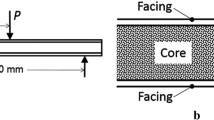Abstract
Based on an analysis of the strengthening and toughening mechanisms of natural composites (shells and pearls) and the biomimetic principle, a new type of hexagonal honeycomb shelter was designed using concrete-filled steel tubes. Experiments were conducted to investigate the anti-penetration properties of the honeycomb shelter. The experimental results showed that in contrast to a reinforced concrete shelter, damage from an impacting projectile only occurred within a single hexagonal unit of the honeycomb shelter; in addition, the damaged area on the honeycomb shelter was relatively small. Furthermore, the projectile tended to yaw when it penetrated the honeycomb shelter. The results of the experiments on the honeycomb shelter were also analyzed in terms of stress wave propagation, which was examined using a numerical simulation. The analysis showed that due to the restriction and obstruction effects of the hexagonal steel tubes on the concrete within the steel tubes, the resistance on the projectile increased during the penetration process, which reduced the damage caused by the projectile. The experimental results and analysis showed that a honeycomb shelter composed of concrete-filled steel tube components exhibits relatively good anti-penetration properties.
Similar content being viewed by others
References
Fang Q., Liu J.: Underground Protective Structures[M]. China Water & Power Press, Beijing (2009)
Austim, C.F.; Halsey, C.C.; Clodt, R.L.: Protective anti-penetration systems development. Technical repeat ESL-TR-83-39, Engineering and services laboratory, Air force engineering and services center, Tyndall air force base, FL (1982)
Gelman, M.D.; Nelson, R.B.; Ito, Y.M.: Non-normal impact of AP projectile into array of large-caliber boulders. Technical report SL-91-2, U.S., Army engineer waterways experiment station, Vicksburg, MS (1991)
Rohani, B.: Shielding methodology for conventional kinetic energy weapon. Technical report SL-87-8, U.S. Army engineer waterways experiment station, Vicksburg, MS (1987)
Cargile, J.D.; Cammins, T.R.: Effectiveness of yaw-inducing bar screens for defeating low length to diameter armor-piercing. Waterways Experimental Station, Vicksburg, MS, 128-137 (1992)
Underwood, J.M.: Effectiveness of Yaw-inducing Deflection Grids for Defeating Advanced Penetrating Weapons. Air Force Civil Engineering Support Agency (1995)
Wang Q.-F., Guo Z.-K., Tian Q. et al.: Experimental study on anti-penetration capabilities of a composite shelter of RPC Pummel on surface [J]. Chin. J. Undergr. Space Eng. 5(5), 0972–0975 (2009)
Szuromi P.: Microstructural engineering of materials. Science 277, 1183 (1997)
Currey J.D.: Mechanical properties of mother of pearl in tension. Proc. R. Soc. Lond B. 196, 443–463 (1977)
Currey, J.D.: Mechanical properties of mollusk shell. In: The Mechanical Properties of Biological Materials (Symp, Soc Exp. Biol.), vol. 34, pp. 75–97. Cambridge: Cambridge University Press (1980)
Jackson A.P., Vincent J.F.V.: The mechanical design of nacre. Proc. R. Soc. Lond. B 234, 415–440 (1980)
Laraia V.J., Heuer A.H.: Novel composite microstructure and mechanical behavior of mollusk shell. J. AM. Ceram. Soc. 72(11), 2177–2179 (1989)
Mening R., Meyers M.H., Meyers M.A. et al.: Quasi-static and dynamic mechanical response of Haliotis rufescens (Abalone) shells. Acta Mater. 48, 2383–2398 (2000)
Jia X.: Natural Biological Materials and Biomimetic Engineering Materials [M]. Chemical Industry Press, Beijing (2007)
Huang Y., Wang C., Jiu Q. et al.: Biomimetic structure design, preparation process and mechanical properties of multiphase ceramics with high toughness [J]. J. Chengdu Univ. 21(3), 1–7 (2002)
Li H., Feng Q., Cui F. et al.: Biomimetic research based on the study of nacre structure. J. Tsinghua Univ. (Sci & Tech) 41, 41–47 (2001)
Mutvei, H.: Ultrastructure of the mineral and organic components of molluscan nacreous Layers. Biominetralization (2), 49–72 (1970)
Bevelander C.B., Nahahara H.: An electron microscope study of the formation of the nacreous layer in the shell of certain bivalve mollusks. Calc. Tiss. Res. 3(1), 84–92 (1965)
Shi S.-Q., Liu Y.-F., Ying P. et al.: Research on a new anti-penetration and anti-blast protective structure. J. Logist. Eng. Univ. 20(3), 9–12 (2004)
Cai S.: Modern Concrete-Filled Steel Tube Structures [M]. China Communications Press, Beijing (2003)
Shi, S.-Q.; Huang, X.-Y.; Liu, Y.-F. et al.: Application of polygonal short steel tube filled with concrete on defense work. Concrete (2), 95–98 (2005)
Author information
Authors and Affiliations
Corresponding author
Rights and permissions
About this article
Cite this article
Wang, QF., Shi, SQ., Chu, ZJ. et al. A Study on the Anti-penetration Properties of a Biomimetic Hexagonal Honeycomb Shelter. Arab J Sci Eng 41, 4161–4170 (2016). https://doi.org/10.1007/s13369-016-2103-9
Received:
Accepted:
Published:
Issue Date:
DOI: https://doi.org/10.1007/s13369-016-2103-9




